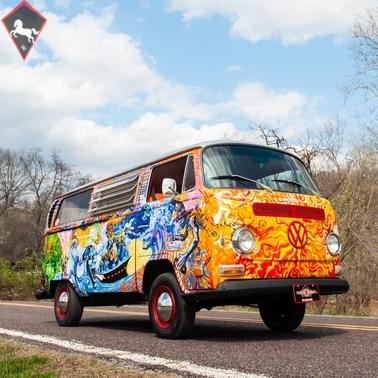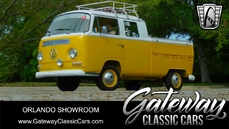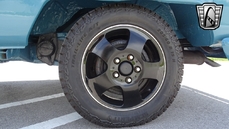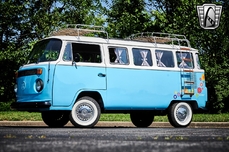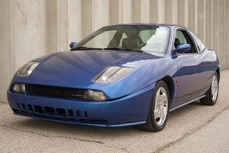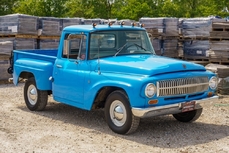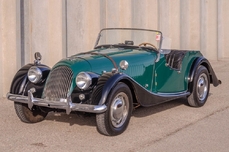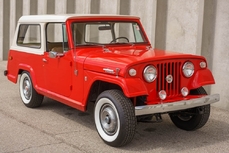Volkswagen Typ 2 (post 1967) Bulli 1.6L Four-cylinder 1971
Allgemeine Beschreibung :
1971 Volkswagen Bus
Early work by Jason McCarty, an Iowa artist who died in the “Ghost Ship” warehouse fire in Oakland, CA in December 2016
Every vertical exterior surface has been transformed into a work of art; roof is silver
Autographed by the artist
Custom interior
1.6L flat four-cylinder engine
Four-speed manual transmission
12-volt electrical system
Power brakes
Documentation includes photos of Jason creating his art, photos of the completed work, high school photos of the artist and Iowa newspaper articles about the fire
On December 16, 2016, a fire started in a warehouse located off of Fruitvale Avenue in Oakland, California. Now known as the “Ghost Ship” Fire, unfortunately 36 people died in the blaze. Artist Jason McCarty was one of them. This VW Bus represents one of his early works completed before he moved to California and it is autographed by McCarty. It was originally a blank red canvas.
An Iowa native, he created art from a very early age. McCarty, 36, dabbled in a variety of media – illustrations, design, photography, painting and music. He moved to California in approximately 2006, when he began his master’s coursework at the San Francisco Art Institute.
The van’s nose is a mélange of warm hues in sun-like pattern. Moving around to the driver’s side, the yellows and oranges become part of a fire-breathing dragon’s exhalations. Past the driver’s door the dragon’s body undulates and a possible underwater scene hovers above the dragon’s back. Over the left rear wheel is a hippie panorama, complete with rainbow, peace signs and other traditional symbols. A large green frog occupies the driver’s D-pillar. Arcing across the rear is an emotive set of sun and moon phases, complete with a long red-and-white stocking cap on the moon. The passenger D-pillar bears a character who would look at home in J.R.R. Tolkien’s “Lord of the Rings” trilogy. Down the passenger side is a very mystical and psychedelic scene, with mushrooms, a Willy Wonka-like character and other images of which Tom Petty would have enjoyed.
The paint and trim are in overall very good order, as are its glass panels and lights. The van’s bodywork is straight while its cargo area is in very good order, however the heater boxes for the engine are missing. The black bumpers are in very good order. The van rolls on Douglas radials, size 185/75R14 at all four corners. The tires are in decent condition and each one surrounds a steel wheel topped with a vented factory wheel cover.
Inside, the newer shag carpet and upholstery are eye-catching. The seats are in excellent order while the matching shag carpet is in very good condition. The headliner is satisfactory, as is the two-spoke steering wheel. The black instrument panel and inner door panels are in very good condition. The fuel gauge is inoperable. Rounding out the interior is a Sony AM/FM stereo. The side entry door has been ingeniously transformed from a slider to a hinged “suicide” door, making it very unique.
In late 1967, the second generation of the Volkswagen Type 2 (T2) was introduced. It was built in Germany until 1979. Models before 1971 are often called the T2a (or “Early Bay.”)
This second-generation Type 2 lost its distinctive split front windshield and was slightly larger and considerably heavier than its predecessor. Its common nicknames are Bread loaf and Bay-window, or Loaf and Bay for short. At 1.6 L, the new engine with dual intake ports on each cylinder head was also slightly larger. The battery and electrical system was upgraded to 12 volts, making it incompatible with electric accessories from the previous generation. The new model also did away with the swing axle rear suspension and transfer boxes previously used to raise ride height. Instead, half-shaft axles fitted with constant velocity joints raised ride height without the wild changes in camber of the Beetle-based swing axle suspension. The updated Bus transaxle is usually sought after by off-road racers using air-cooled Volkswagen components.
The first models featured rounded bumpers incorporating a step for use when the door was open (replaced by indented bumpers without steps on later models), front doors that opened to 90° from the body, no lip on the front guards, unique engine hatches and crescent air intakes in the D-pillars. An important change came with the introduction of front disc brakes and new roadwheels with brake ventilation holes and flatter hubcaps. Up until 1972, front indicators are set low on the nose rather than high on either side of the fresh air grille – giving rise to their being nicknamed “Low Lights.”
Competition to this Volkswagen in 1971 included Chevrolet’s G-Series Van, Dodge’s B-100, Ford’s Econoline, GMC’s VanDura.
Documentation includes photos of Jason creating his art, photos of the completed work, high school photos of the artist and Iowa newspaper articles about the fire.
This is more than a typical Volkswagen Bus, this is an artist’s rolling mural from a segment of his life. If you are interested in this unique VW, please stop by MotoeXotica Classic Cars as soon as possible.
PLEASE CLICK HERE TO VIEW OUR YOU TUBE VIDEO!
OR COPY AND PASTE THE LINK BELOW INTO YOUR WEB BROWSER:
https://youtu.be/0CE2y5r6hik
This car is currently located at our facility in St. Louis, Missouri. Current mileage on the odometer shows 62,881 miles. It is sold as is, where is, on a clean and clear, mileage exempt title. GET OUT AND DRIVE!!!
VIN: 2312043507
https://www.motoexotica.com/inventory/listing/1971-volkswagen-bus/
1971 Volkswagen Typ 2 (post 1967) Bulli 1.6L Four-cylinder is listed verkauft on ClassicDigest in Fenton (St. Louis) by for $26900.
Fakten der Auto
Karosserietyp : Auto Marke : Volkswagen Modell : Typ 2 (post 1967) Bulli Ausführung : 1.6L Four-cylinder Hubraum : 1.6 Modelljahr : 1971 Karosstyp : Lieferwagen Lage : Fenton (St. Louis)
Verkauft
Angaben Zum Verkäufer
Verkauft
People who viewed this Volkswagen Typ 2 (post 1967) Bulli also viewed similar Volkswagen listed at ClassicDigest
Other cars listed for sale by this dealer
über Volkswagen
Die Volkswagen-Geschichte ist in der Tat eine faszinierende Geschichte von Innovation, Belastbarkeit und Wiederbelebung nach dem Krieg, die von verschiedenen Modellen gekennzeichnet ist, die in der Automobilgeschichte zu Ikone geworden sind.Das Volksauto (Volkswagen): Zunächst von Adolf Hitler in den 1930er Jahren als "Volksauto" oder "Volkswagen" auf Deutsch vorgestellt, war die Idee, ein erschwingliches und praktisches Fahrzeug für das deutsche Volk zu schaffen. Dieses Konzept führte zur Entwicklung des von Ferdinand Porsche entworfenen Volkswagenkäfers (oder des Typ 1).
Nachkriegsherausforderungen: Nach dem Zweiten Weltkrieg stand Volkswagen erhebliche Herausforderungen. Die Fabrik war stark beschädigt, und die Verbindung der Marke mit dem NS -Regime führte in einigen Regionen zu einem mangelnden Interesse an dem Auto.
Britische Intervention - Die britische Armee & Ivan Hirst: Die britische Armee übernahm die Kontrolle über die Fabrik in der unmittelbaren Nachkriegszeit. Major Ivan Hirst, ein Offizier der britischen Armee, spielte eine entscheidende Rolle bei der Wiederbelebung von Volkswagen. Er erkannte das Potenzial des Käfers und setzte sich für seine Produktion ein. Er überzeugte das britische Militär, mehrere tausend Autos zu bestellen. Diese Entscheidung hat dazu beigetragen, die Wiederbelebung der Marke zu starten.
Exporterfolg und der globale Anziehungskraft des Käfers: Der Käfer gewann nicht nur in Deutschland, sondern auch weltweit an Popularität und wurde zu einer Ikone des erschwinglichen Fahrwerks. Das einfache, zuverlässige Design und das einzigartige Erscheinungsbild machten es zu einem Favoriten unter den Verbrauchern weltweit.
Modellentwicklung: Im Laufe der Jahre führte Volkswagen verschiedene Modelle neben dem Käfer ein, wobei jeder zum Wachstum der Marke beitrug:
Typ 2 (VW -Bus oder Transporter): In den 1950er Jahren wurde er in den 1960er Jahren zu einem ikonischen Symbol der Hippie -Bewegung eingeführt und wurde wegen seiner Geräumigkeit und Vielseitigkeit geliebt.
Golf (Kaninchen in den USA): Der Golf (oder Kaninchen in den USA) wurde Mitte der 1970er Jahre ins Leben gerufen und markierte eine Verlagerung in Richtung Frontantrieb, modernes Design und Schrägheckpraktikabilität und wurde zu einem Eckpfeiler des Erfolgs der Marke.
Passat, Jetta und andere Modelle: Volkswagen erweiterte seine Aufstellung mit Modellen wie dem Passat und Jetta, die sich für verschiedene Marktsegmente befassen.
Herausforderungen und Innovationen: Trotz des Erfolgs stand Volkswagen vor Herausforderungen, einschließlich Qualitätsproblemen in den 1970er Jahren. Die Marke hat jedoch weiterhin neue Modelle und Technologien entwickelt und entwickelt.
Aufstieg des GTI und globaler Expansion: In den 1980er Jahren stieg der legendäre Golf GTI auf, eine Hochleistungsversion, die den Trend der heißen Luke auslöste. Volkswagen erweiterte auch seine globale Präsenz in diesem Zeitraum.
Die britische Intervention bei der Wiederbelebung von Volkswagen nach dem Zweiten Weltkrieg spielte eine entscheidende Rolle bei der Wiederbelebung der Marke. Während es in den 1950er und 1960er Jahren aufgrund des Erfolgs von Volkswagen in den 1950er und 1960er Jahren möglicherweise einige Spannungen oder einen Wettbewerb zwischen Automobilunternehmen gegeben hat, hat die Fähigkeit der Marke, innovative und beliebte Modelle zu produzieren, ihren Platz in der Automobilgeschichte festigend.
